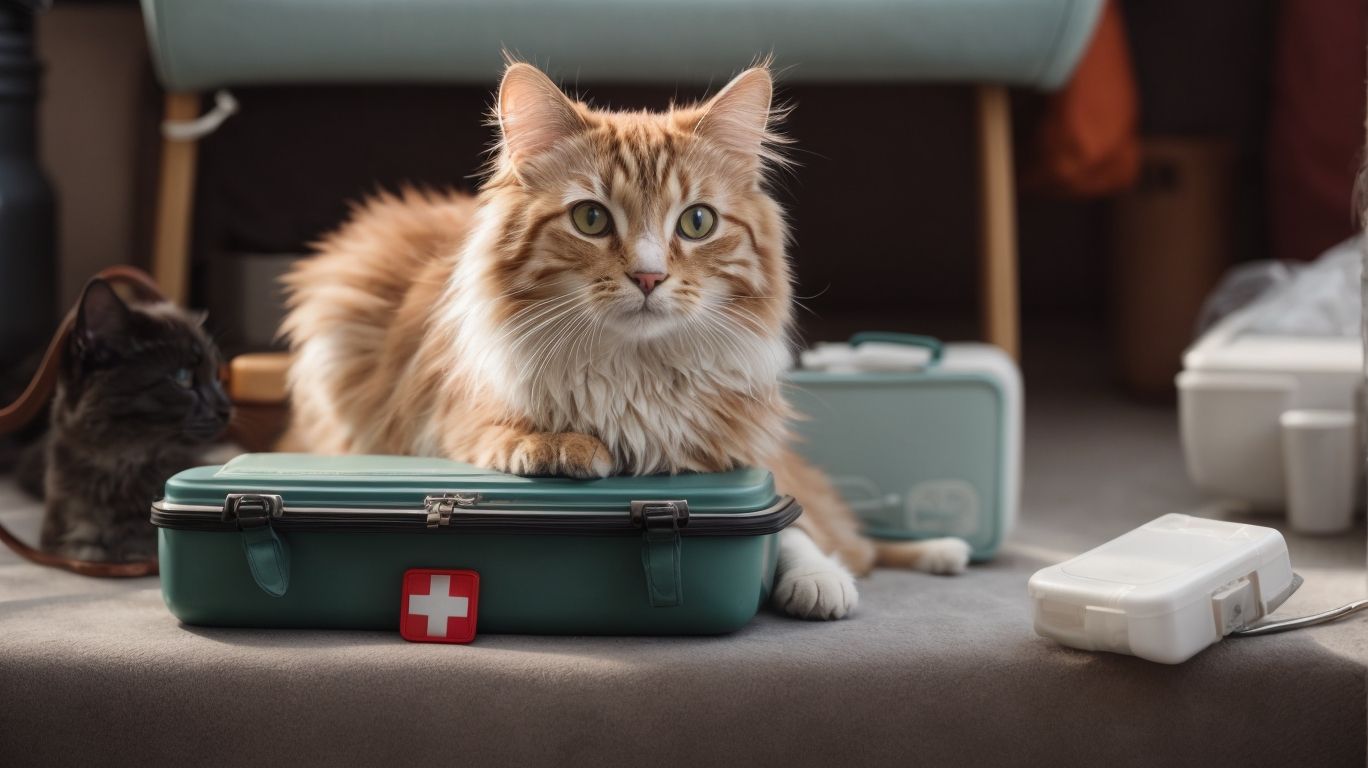.jpg)
Pet First Aid is the immediate and temporary care given to a pet during an emergency or injury before professional help can be sought. Just like humans, pets can also face accidents or emergencies, and having a pet first aid kit ready can help you provide immediate care and potentially save their life.
According to the American Veterinary Medical Association, having a pet first aid kit is crucial in case of emergencies where you may not have access to a veterinarian. It can also help in providing temporary care until you can get your pet to a professional.
Some essential items that should be included in a pet first aid kit are:
- gauze pads
- bandages
- antiseptic wipes
- saline solution
- hydrogen peroxide
It is also essential to have a copy of your pet's medical records, including vaccination history, in the kit.
Knowing how to perform basic first aid on your pet is also crucial. In case of choking, try to remove the object using tweezers or your fingers. If your pet is bleeding, apply pressure to the wound with a clean cloth or bandage. If your pet is having a seizure, keep them away from any objects that could harm them and monitor their condition.
It is crucial to seek professional help if your pet's condition does not improve or if they are showing signs of heatstroke, which include excessive panting, drooling, and weakness.
Preventing pet emergencies is also essential. This can include keeping your pet's vaccinations up to date, providing a safe environment for them to play and exercise, and regularly checking for any health issues. Having a pet first aid kit and knowing how to use it can give you peace of mind and help you provide immediate care in case of an emergency.
- First Aid Kit for Pets:
- Petco's Pet First Aid Kit
- Amazon's Best Sellers in Pet First Aid Kits
- Educational Websites on Pet First Aid:
- First Aid Mobile Apps:
- Pet First Aid Courses:
- Certification Programs:
Pet First Aid Key Takeaways:
- Always have a pet first aid kit ready in case of emergencies.
- Include items such as bandages, antiseptic, and a pet thermometer in your kit.
- Learn basic first aid techniques for pets, including what to do in case of choking, bleeding, seizures, unconsciousness, and heatstroke.
What is Pet First Aid?
Pet first aid is the immediate care provided to pets in case of injury or illness. It encompasses basic wound care, CPR, and knowing how to handle common emergencies. Understanding what pet first aid is is essential for pet owners to ensure their beloved animals receive timely and appropriate medical attention.
Why is it Important to Have a Pet First Aid Kit?
Having a pet first aid kit is crucial for addressing minor injuries or managing emergencies. It provides immediate care before reaching a vet and can prevent a situation from worsening. A well-equipped kit ensures readiness for any unexpected mishaps, giving pet owners peace of mind.
Consider including items such as:
- bandages
- gauze
- antiseptic wipes
- a pet first aid manual
- your pet's medical records
in the kit. Regularly check and replenish supplies to maintain its effectiveness and to ensure that you are prepared for any potential emergencies that may arise for your beloved pet.
What Items Should Be Included in a Pet First Aid Kit?
A comprehensive pet first aid kit should include:
- Bandages and gauze for wrapping wounds
- Antiseptic wipes or spray for cleaning wounds
- Hydrogen peroxide for inducing vomiting (only under veterinary guidance)
- Scissors, tweezers, and a tick removal tool
- Instant cold pack for reducing swelling
- Self-adhering wrap for securing bandages
Pro-tip: Be sure to regularly check and replenish your pet first aid kit to ensure all items are within their expiration dates and in good condition.

How to Perform Basic First Aid on Your Pet
- Before approaching the pet, assess the situation and ensure your safety.
- Remain calm and gently restrain the pet to prevent any further injury.
- If there is any bleeding, apply pressure to the wound using a clean cloth or bandage.
- For fractures, stabilize them by creating splints with a padded board or towel.
- If the pet is not breathing, check for a heartbeat and administer CPR if necessary.
What to Do If Your Pet is Choking?
- In the event that your pet is choking, it is important to remain calm and assess the situation before taking action.
- If your pet is still able to breathe, do not interfere and instead, quickly bring them to a veterinarian for assistance.
- However, if your pet is unable to cough or breathe, you can perform a modified Heimlich maneuver by placing your hands just below the ribcage and applying quick, firm pressure.
- Once the obstruction is dislodged, it is crucial to seek immediate veterinary attention to check for any potential injuries.
What to Do If Your Pet is Bleeding?
If your pet is bleeding, it is important to stay calm and take immediate action. Gently apply pressure to the wound with a clean cloth or bandage and try to elevate the wound if possible. In case of severe bleeding, cover the wound with a clean cloth and apply firm pressure. It is crucial to transport your pet to the vet as soon as possible for professional care and evaluation.
For future emergencies, it is recommended to keep a pet first aid kit easily accessible at home and in your car.
Just remember, when your pet is seizing, stay calm and don't panic - they're just practicing their dance moves!
What to Do If Your Pet is Having a Seizure?
- Ensure safety: If your pet is having a seizure, make sure to keep the area around them clear of any objects that could harm them.
- Stay calm: It is important to remain calm and reassuring to prevent further stress for your pet during the seizure.
- Do not restrain: It is best to avoid holding or restraining your pet during the seizure, as it could lead to injury for both you and your pet.
- Time the seizure: Take note of the duration of the seizure to provide crucial information to the veterinarian.
- Comfort post-seizure: After the seizure ends, create a quiet and soothing environment for your pet to recover.
If your pet's unconscious, don't panic, just act fast and follow these steps to ensure they wake up feeling fur-tastic.
What to Do If Your Pet is Unconscious?
If your pet is unconscious, it is important to first ensure their safety. Then, check for responsiveness and breathing. Carefully place them on their right side and secure their head and neck. Check for any obstructions in the airway and perform artificial respiration if necessary. It is crucial to monitor their vital signs and seek immediate veterinary attention.
Remember to always keep your pet's medical records and emergency contact numbers easily accessible in case of any emergencies.
Don't panic, just keep your pet cool and hydrated - because we all know a hot dog is never a good thing.
What to Do If Your Pet is Showing Signs of Heatstroke?
If your pet is displaying symptoms of heatstroke, it is important to act quickly. Immediately move them to a cool area, offer them water to drink, and use cool (not cold) water to dampen their fur. Apply cool packs to their head, neck, and chest and seek veterinary assistance without delay.
Last summer, my dog showed signs of heatstroke after a lengthy walk. I promptly followed these steps and rushed him to the veterinarian. Thanks to swift action, he made a complete recovery.
Don't be afraid to call the vet, they have a pet-ient ear for emergencies.
When to Seek Professional Help
Knowing when to seek professional help for your furry companion is essential for their overall health and well-being. Seeking professional assistance is crucial in cases of severe injuries, ingestion of toxic substances, and uncontrolled bleeding. Furthermore, if your pet displays persistent symptoms such as vomiting, diarrhea, or lethargy, it is imperative to promptly consult a veterinarian. Being able to recognize the appropriate time to seek professional help can greatly impact your pet's recovery.
Preventing Pet Emergencies
As pet owners, it is our responsibility to be prepared for any potential emergencies that may arise. In this section, we will discuss ways to prevent pet emergencies and ensure the safety and well-being of our beloved companions. From keeping vaccinations up to date to creating a safe environment, we'll cover essential steps to minimize the risk of emergencies. We'll also touch upon the importance of regularly checking for any health issues that may require immediate attention.
Keeping Your Pet's Vaccinations Up to Date
- Schedule regular veterinary check-ups for your pet to ensure their vaccinations are up to date.
- Discuss with your vet to determine which vaccinations are necessary based on your pet's lifestyle and health condition.
- Keep a record of vaccination dates and set reminders for upcoming vaccinations to keep your pet protected.
- Follow your veterinarian's advice on the timing and frequency of vaccinations to maintain your pet's immunity.
- Be sure to update your pet's vaccination certificates and inform relevant authorities if required to keep everything in order.
Providing a Safe Environment for Your Pet
- Creating a Safe Environment: To ensure the safety of your pet, it is important to remove any hazardous items such as small toys, electrical cords, and toxic plants to prevent accidental ingestion or injury.
- Supervision is Key: It is crucial to keep a close eye on your pet to prevent access to dangerous areas or substances.
- Space is Essential: Make sure to provide your pet with a comfortable and spacious living area that allows for movement and play without any obstructions.
- Cleanliness is Crucial: Regularly cleaning and disinfecting the living space is necessary to prevent infections or other potential health hazards.
- Temperature Control: Keeping the environment at a suitable temperature is important to avoid heatstroke or hypothermia for your pet.
Regularly Checking for Any Health Issues
- Be sure to regularly check for any changes in appetite, water intake, or bathroom habits.
- Observe for unusual lumps, bumps, or skin discoloration that could indicate underlying health issues.
- Monitor your pet's behavior for any changes, such as lethargy, excessive barking, or aggression, as these could also be signs of health issues.
- Maintain good dental health by keeping an eye out for bad breath, yellowing teeth, or inflamed gums.
- Don't forget to schedule routine veterinary check-ups to stay on top of your pet's health and detect any issues early on.
Frequently Asked Questions
1. What is a pet first aid kit and why is it important to have one?
A pet first aid kit is a collection of necessary supplies that can help treat minor injuries or provide immediate care for your pet in case of emergencies or natural disasters. It is important to have one on hand to be prepared for unexpected situations and to potentially save your pet's life.
2. What are some key items that should be included in a pet first aid kit?
Some key items that should be included in a pet first aid kit are wound care supplies such as non-stick bandages, gauze, and antiseptic wipes, medications like hydrogen peroxide and eye wash solution, tools like bandage scissors and a digital thermometer, and miscellaneous items like a rescue blanket and a collapsible water bowl.
3. Can I use human medicine on my pet in case of an emergency?
No, it is not recommended to use human medicine on your pet unless specifically instructed by a veterinarian. Some human medications can be toxic to animals, and it is best to stick to pet-specific first aid supplies.
4. What should I do if my pet is bitten by a snake?
In case of a snake bite, it is important to seek immediate medical treatment at a veterinary emergency clinic. Take note of the type of snake if possible, and do not attempt to remove any venom or give any medication without consulting with a veterinarian or animal poison control expert.
5. How often should I check and update my pet's first aid kit?
It is recommended to check and update your pet's first aid kit every six months. This ensures that all supplies are not expired and are still in good condition in case of an emergency.
6. Can I purchase a pre-built pet first aid kit or should I create my own?
You can purchase a pre-built pet first aid kit, but it is also recommended to create your own customized kit to cater to your pet's specific needs and size. Make sure to include necessary supplies and contact information for your pet's veterinarian and a poison control hotline in case of serious emergencies.



